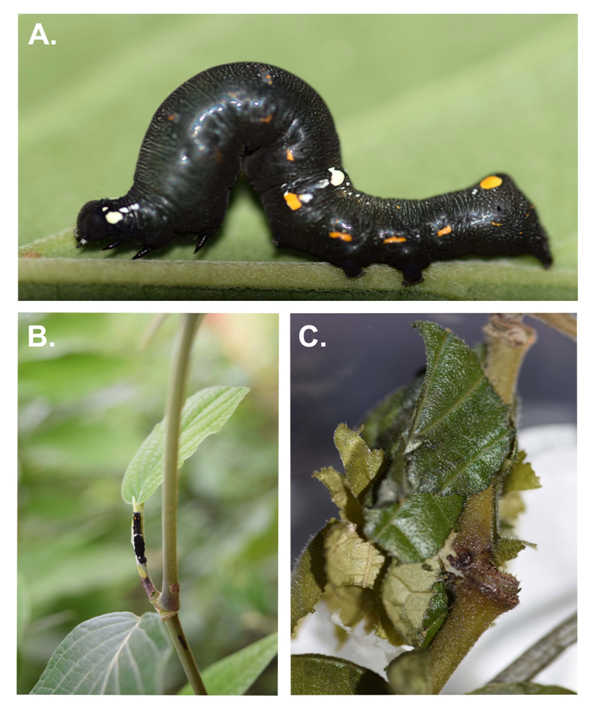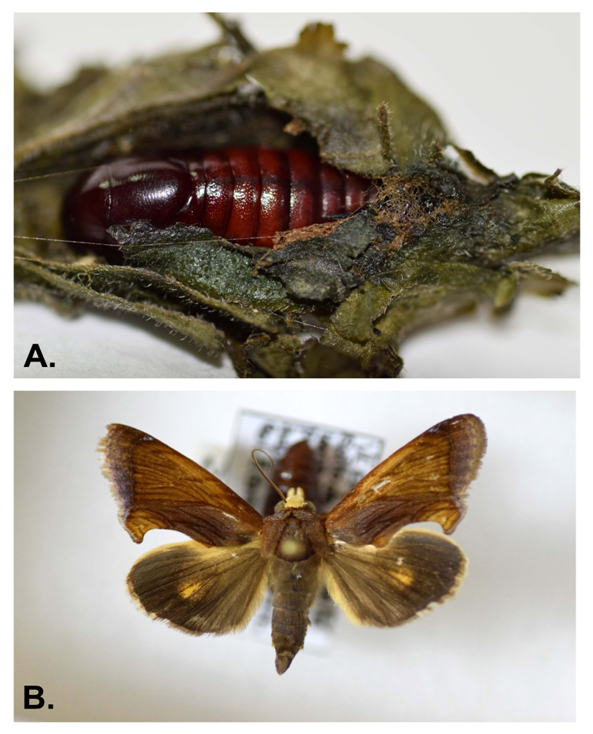International Journal of
eISSN: 2574-9862


Short Communication Volume 3 Issue 6
Department of Entomology, University of Panam
Correspondence: Patricia Esther Corro Chang, Department of Entomology, Edif. Gemelos, Vice-Rector for Research and Postgraduate Studies, University of Panammá, Panamá
Received: October 23, 2018 | Published: November 8, 2018
Citation: Chang PEC. Panama moths: notes on the life history of Gonodonta incurva (Sepp, [1840]) (Erebidae, Calpinae). Int J Avian & Wildlife Biol. 2018;3(6):405-407. DOI: 10.15406/ijawb.2018.03.00129
The Neotropical genus Gonodonta Hübner, 1818 includes 39 species for Panamá, and a total of 55 barcodes with several new species to be described. This work presents behavioral notes and a new altitudinal record for G. incurva (Sepp, [1840]), in Panamá.
Keywords: panama moth series, conservation, wildlife biology
Todd1,2 reviewed the neotropical genus Gonodonta Hübner, 1818, reporting 39 species. The species have a significant impact on agriculture, feeding on fruits of the families Annonaceae, Anacardiaceae, Solanaceae and Rutaceae. The adult moths pierce the strong cuticles of the fruits, thus reducing their commercial value. This feeding habit gives them the common name of “fruit piercing moths.” Some studies suggest that in the Neotropics larvae affect 85% of the cultivated yields and 30% defoliation.3,4 Besides their agricultural impact, species of the genus Gonodonta can live in non cultivated areas, feeding on a wide variety of plants. The adults on flight are important pollinators of Neotropical plants, including endangered species of orchids. However, to understand their possible associations and beneficial relationships to different species; it is important to increase studies on life histories and behavioral patterns in the Neotropics. The following work is part of the Panamanian moth’s series that will provide notes on behavior and life histories, and promote conservation of the moth fauna and wildlife sources in Latin American countries.
GONODONTA HÜBNER, 1818
Gonodonta uncina Hübner, 1818
Athysania Hübner, 1823
Phalaena chorinea Stoll, 1780
Dosa Walker, 1865
Dosa obesa Walker, 1865
The genus Gonodonta Hübner, 1818 was described based on a Brazilian species, G. uncina Hübner. Morphological studies based on dissections of the genitalia suggest that G. uncina is a junior synonym of G. sicheas (Cramer, 1777). It is likely that a considerable number of species remain unknown to science. Through basic studies of the group; we can learn about their life histories, and thus their important niches within ecosystems. That information will provide valuable insights into the natural history of the rich Neotropical moth fauna that awaits study.
Gonodonta incurva (Sepp, [1840])
Phalaena incurva Sepp, 1832, synonym
Larva: 5 instars. Length at maturity: 6-30 mm; blackish, prothorax with yellow dots, laterally; abdomen with orange maculae on each segment, laterally. In preparation for pupation, the final stage larva (prepupa) builds a cocoon consisting of pieces of leaves, pasted together with silk threads (Figure 1).

Figure 1 Life history of Gonodonta incurva (Sepp, [1840]). A. Final stadium larva of G. incurva before construction of the cocoon; B. Second stadium of G. incurva feeding on Piper duckei (Piperaceae); C. Cocoon made by G. incurva under standardized lab conditions.
Pupa: Length: 21.91 mm; dark brown, punctuate dorsally; inside cocoon (Figure 2).

Figure 2 Gonodonta incurva (Sepp, [1840]). A. Cocoon opened to show the dorsal view of the pupa inside. B. Dorsal view, adult of G. incurva (Sepp, [1840]) reared under standardized lab conditions.
Adult: Wingspan: 38.33 mm; brownish except head, which is partially covered with yellow scales. Abdomen: brownish, yellow ventrally. Forewings: light brown, termen provided with purple patches; hind wings gray, with a round yellow macula, evanescent, on the discal cell. The adult assumes a tented resting position, which is cryptic on dry wood surfaces (Figure 2B). The adults can live 20 days feeding on nectar, while the complete life history can span 65 days at 20˚C. The males are attracted to mercury vapor lights on warm nights with no moon and after rain, when moisture increases.
♂ Genitalia: Coremata tuft-like, ventrally inserted at segment VIII (Figure 3); tegumen sub-rectangular, elongated; vinculum sub-triangular; juxta lobes sub-quadrangular, bifurcate distally; hook-like uncus, covered with erect setae; valva (Figure 4); saccus protuberant, sclerotized, sub-triangular, 0.5 times length of valva; aedeagus sub-rectangular, sclerotized, cornuti minute, sclerotized, tooth-like, distally.

Figure 3 A Gonodonta incurva (Sepp, [1840])abdomen; B. Abdominal pelts of Gonodonta species, showing ventral view; C. tuft-like coremata.
Remarks: According to Todd,1 the type specimen of G. incurva (Sepp, [1840]) has been lost, and the original description was based on material from Suriname.
Biology: The larvae reared in this study ate Piper duckei C. D. (Piperaceae). The literature states that the species can be found from 400 to 1,000 m.a.s.l.1 But the inventories carried out in Panamá show that G. incurva (Sepp, [1840]) can occur as low as 110 m.a.s.l. representing a new altitudinal record for the species. Our field observations suggest a particular preference for environments with high humidity, 70% to 90% in areas with moderate anthropogenic disturbance.
Distribution: Widespread throughout the Americas except arid areas.1 This study confirms the presence of the species in Panamá.
The larvae raised in this study were collected in Veraguas Province, at El Mirador, on a trail near a river (08.2599° N; 080.9760° W), República de Panamá. The life history records include larva: 12 days; pupa: 20 days; adult: 5 days. The material was collected at the beginning of the rainy season (June, 2016). The reared material and vouchers of plant damage are deposited in the personal collection of Patricia Corro-Chang, at Programa Centroamericano de Maestría en Entomología (PCMENT).
This work is a short contribution to the knowledge of life histories of the rich diversity of Panamanian moths. The author encourages systematic inventories in the region in order to understand patterns of seasonality, and provide biological information about the Neotropical fauna.
Thanks to Dr. John Heppner (University of Florida, McGuire Lepidoptera Center) for his support with literature during my studies in Panamá and Dr. Annette Aiello (Smithsonian Tropical Research Institute) for her comments improving the English grammar of this manuscript.
The author declares that there is no conflict of interest.

©2018 Chang. This is an open access article distributed under the terms of the, which permits unrestricted use, distribution, and build upon your work non-commercially.